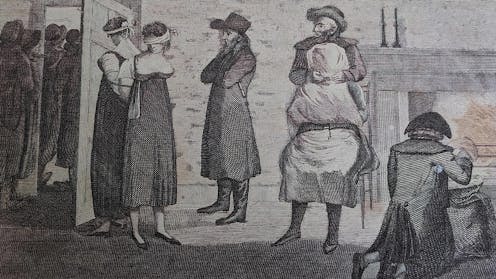Source: The Conversation – UK – By Ming Gao, Research Fellow of East Asia Studies, Lund University
In the 2025 global gender gap index (GGGI), Japan ranks 118th out of 148 countries – still the lowest among the G7 nations and among the poorest performers globally. This is largely because of limited political participation by women. The current cabinet of prime minister Ishiba Shigeru says it all. In October 2024, Japan’s new prime minister appointed only two women to a 20-member cabinet – down from five in the previous lineup.
The decision was widely criticised as a setback for advancing female political representation and a clear sign that gender-equality policies were not a priority.
But the country has continued to take backward steps on gender. In January, Japan announced it would halt funding for the UN’s Committee on the Elimination of Discrimination against Women (Cedaw). The decision followed Cedaw’s recommendation that Japan revise its male-only imperial succession law to ensure gender equality in the line to the throne.
The funding halt sparked a strong backlash from rights advocates, who viewed it as further evidence of Japan’s resistance to addressing structural discrimination against women.
The debate over Japan’s imperial succession has surfaced periodically for decades. Since 1947, the Imperial Household Law has stipulated that only men from the patrilineal line can ascend what is known as the Chrysanthemum throne. This rule has led to concerns over the future of the imperial family, given the shrinking number of male heirs.
Japan’s Emperor Naruhito turned 65 on February 23 and has only three male heirs. These are his uncle Prince Hitachi (aged 89), his younger brother Crown Prince Fumihito (59), and his nephew Prince Hisahito, who is 18.
A poll of around 2,000 people taken in April 2024 by Kyodo News found 90% of respondents support allowing female emperors. Yet successive governments have remained steadfast in resisting change, with some citing the so-called unbroken imperial lineage (bansei ikkei).
Ishiba is known to favour allowing a female succession. But his administration’s financial retaliation against Cedaw signals otherwise. The decision is not merely a reaction to a non-binding recommendation – it reflects deeper discomfort with external scrutiny over Japan’s gender policies, which the current government has deprioritised.
Cedaw’s recommendation to Japan that it might reconsider its imperial succession system was not an isolated critique. The UN committee has regularly called on Japan to improve gender equality in multiple areas. These include workplace discrimination, representation in politics and legal protections against gender-based violence.
Cedaw’s recommendation on inclusive succession is neither legally binding nor “within the purview of the Committee’s competence”, as the committee itself acknowledges. As a result the government’s response – cutting funding – is more than just a reaction to Cedaw’s recommendation. It raises concerns about Japan’s commitment to gender equality full stop.
The United Nations has clashed with successive Japanese governments over a range of gender-related issues. These have included the refusal of Japan to allow brides to retain their maiden names. Cedaw has recommended that Japan amend the Civil Code over the surname requirement in 2003, 2009 and 2016. The most recent occasion is marked the recommendation as having high importance.
But the most important issue is over Japan’s treatment of what it called “comfort women” – the system of military sexual slavery before and during the second world war. Cedaw and other UN bodies have repeatedly urged Japan to resolve the issue by firstly recognising the gravity of the crimes involved and dealing with reparations for survivors and strengthen education on the issue.
Japan has frequently been accused of downplaying this issue. While official apologies have been made, they have frequently been coupled with denials or diplomatic efforts to dilute past statements. In its last report in 2016, Cedaw called on Japan to ensure its leaders and public officials “desist from making disparaging statements regarding responsibility, which have the effect of retraumatising victims”.
Poor track record
Japan’s relationship with international organisations addressing gender issues has long been uneasy and its domestic policies frequently lag behind international expectations. Reports from the committee have criticised Japan’s inadequate legal definitions of discrimination against women, limited access to justice for women, and the persistence of deep-seated gender stereotypes and patriarchal attitudes.
This year holds special significance for the UN, marking two major anniversaries. It’s the 30th anniversary of the United Nations fourth world conference on women. This produced the Beijing declaration and platform for action – the most widely endorsed global agenda for women’s rights. And it’s the 25th anniversary of the UN’s adoption of Resolution 1325. This established the Women, Peace and Security (WPS) agenda. WPS is now recognised as a key pillar of international peace and security, regarded by the European Parliament’s committee on women’s rights and gender equality as “central to contemporary global peace and security challenges”.
Amid increasing global support for women-led initiatives, Japan’s decision to halt funding for Cedaw in 2025 risks damaging its status as a responsible and respected nation on the world stage. It also risks alienating allies that prioritise gender equality in diplomacy.
In distancing itself from global norms, Japan risks not just falling behind, but falling out of step with most of its G7 peers.
![]()
Ming Gao receives funding from the Swedish Research Council. This research was produced with support from the Swedish Research Council grant “Moved Apart” (nr. 2022-01864). Ming Gao is a member of Lund University Profile Area: Human Rights.
– ref. Japan’s problem with women’s equality is getting worse, not better – https://theconversation.com/japans-problem-with-womens-equality-is-getting-worse-not-better-249762
















